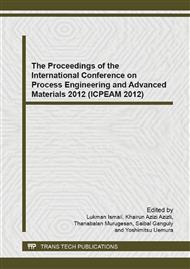[1]
D. Burkolter, A. Kluge, J. Sauer, and S. Ritzmann, Comparative Study of Three Training Methods for Enhancing Process Control Performance: Emphasis Shift Training, Situation Awareness Training, and Drill and Practice, Comput. Hum. Behav. 26(5) (2010).
DOI: 10.1016/j.chb.2010.02.011
Google Scholar
[2]
K.P. Prem, D. Ng, and M.S. Mannan, Harnessing Database Resources for Understanding the Profile of Chemical Process Industry Incidents, J. Loss Prev. Proc. Ind. 23(4) (2010), 549-560.
DOI: 10.1016/j.jlp.2010.05.003
Google Scholar
[3]
W. Duan, G. Chen, Q. Ye, and Q. Chen, The Situation of Hazardous Chemical Accidents in China between 2000 and 2006, J. Hazard. Mate. 186(2-3) (2011), 1489-1494.
DOI: 10.1016/j.jhazmat.2010.12.029
Google Scholar
[4]
J. Park, W. Jung, J. Ha, and Y. Shin, Analysis of Operators' Performance under Emergencies Using a Training Simulator of the Nuclear Power Plant, Reliab. Eng. Syst. Saf. 83(2) (2004), 179-186.
DOI: 10.1016/j.ress.2003.09.009
Google Scholar
[5]
J.K. Vaurio, Human Factors, Human Reliability and Risk Assessment in License Renewal of a Nuclear Power Plant, in Reliab. Eng. Syst. Saf. (2009), 1818-1826.
DOI: 10.1016/j.ress.2009.05.014
Google Scholar
[6]
S.H. Yang, L. Yang, and C.H. He, Improve Safety of Industrial Processes Using Dynamic Operator Training Simulators, Process Saf. Env. 79(6) (2001), 329-338.
DOI: 10.1205/095758201753373096
Google Scholar
[7]
E. Mason, Elements of Process Safety Management: Part 2, J. Chem. Health Saf. 8(5) (2001), 23-26.
Google Scholar
[8]
H.A. Aziz, A.M. Shariff, and R. Rusli, Managing Process Safety Information Based on Process Safety Management Requirements, Process Saf. Prog. 00(00) (2013), 1-8.
DOI: 10.1002/prs.11610
Google Scholar
[9]
R. Pitblado, Global Process Industry Initiatives to Reduce Major Accident Hazards, J. Loss Prev. Proc. Ind. 24(1) (2011), 57-62.
DOI: 10.1016/j.jlp.2010.08.006
Google Scholar
[10]
G.B. DeWolf, Process Safety Management in the Pipeline Industry: Parallels and Differences between the Pipeline Integrity Management (Imp) Rule of the Office of Pipeline Safety and the Psm/Rmp Approach for Process Facilities, J. Hazard. Mate. 104(1-3) (2003).
DOI: 10.1016/j.jhazmat.2003.08.008
Google Scholar
[11]
W.F. Early, Database Management Systems for Process Safety, J. Hazard. Mate. 130(1-2) (2006), 53-57.
Google Scholar
[12]
M. Kho. Strengthening Process Safety Requirements in Hse Management System an Noc's Experience. AIChE PPSS conference. (2008).
Google Scholar
[13]
V. Zaloom and P. Ramachandran, A Computer Based Training System for Process Safety Management, Comput. Hum. Behav. 31(1-2) (1996), 511-514.
DOI: 10.1016/0360-8352(96)00187-8
Google Scholar
[14]
P.M. Myers, B. Watson, and M. Watson, Effective Training Programs Using Instructional Systems Design and E-Learning, Process Saf. Prog. 27(2) (2008), 131-138.
DOI: 10.1002/prs.10245
Google Scholar
[15]
J.A. Klein, Operational Discipline in the Workplace, Process Saf. Prog. 24(4) (2005), 228-235.
Google Scholar
[16]
J. Louvar, Guidance for Safety Performance Indicators, Process Saf. Prog. 29(4) (2010), 387-388.
DOI: 10.1002/prs.10418
Google Scholar
[17]
A.S. West, Plant Process Safety Starts in the Laboratory, J. Chem. Health Saf. 15 March/Apr (1999), 15-17.
DOI: 10.1016/s1074-9098(00)80010-6
Google Scholar
[18]
N. Langerman, Management of Change for Laboratories and Pilot Plants, Org. Process Res. Dev. 12(6) (2008), 1305–1306.
DOI: 10.1021/op8001855
Google Scholar
[19]
N. Langerman, Lab-Scale Process Safety Management, J. Chem. Health Saf. (July/August) (2009), 22-28.
Google Scholar


